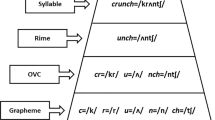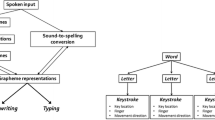Summary
Dual-route models assume that pronunciations are generated along both a lexical route and a nonlexical route. The lexical route has been characterized as more automatic. Accordingly, if the naming task is paired with a concurrent task, then the nonlexical route should be more susceptible to interference than the lexical pathway. A relative slowing of the nonlexical route should eliminate the regularity effect obtained with low-frequency words while significantly enhancing the small frequency effect obtained with regular words. These predictions were confirmed. Exception words were actually named 39 ms faster under high load. The results are inconsistent with any straightforward application of single-route models.
Similar content being viewed by others
References
Barber, P. J., & Millar, D. G. (1982). Subjective judgements of spellingsound correspondences: Effects of word regularity and word frequency.Memory & Cognition, 10, 457–464.
Becker, C. A. (1976). Allocation of attention during visual word recognition.Journal of Experimental Psychology: Human Perception and Performance, 2, 556–566.
Coltheart, M., Besner, D., Jonassen, J. T., & Davelaar, E. (1979). Phonological encoding in the lexical decision task.Quarterly Journal of Experimental Psychology, 31, 489–507.
Davelaar, E., Coltheart, M., Besner, D., & Jonasson, J. T. (1978). Phonological recoding and lexical access.Memory & Cognition, 6, 391–402.
Feldman, L. B., & Turvey, M. T. (1983). Word recognition in SerboCroatian is phonologically analytic.Journal of Experimental Psychology: Human Perception and Performance, 9, 288–298.
Frost, R., Katz, L., & Bentin, S. (1987). Strategies for visual word recognition and orthographical depth: A multilingual comparison.Journal of Experimental Psychology: Human Perception and Performance, 13, 104–115.
Glushko, R. J. (1979). The organization and activation of orthographic knowledge in reading aloud.Journal of Experimental Psychology: Human Perception and Performance, 5, 674–691.
Glushko, R. J. (1981). Principles for pronouncing print: The psychology of phonography. In A. M. Lesgold & C. A. Perfetti (Eds.),Interactive processes in reading (pp. 61–84). Hillsdale, NJ: Erlbaum.
Herdman, C. M., & Dobbs, A. R. (1989). Attentional demands of visual word recognition.Journal ofExperimental Psychology: Human Perception and Performance, 15, 124–132.
Humphreys, G. W., & Evett, L. (1985). Are there independent lexical and nonlexical routes in word processing? An evaluation of the dual route theory of reading.Behavioral & Brain Sciences, 8, 689–739.
Kucera, H., & Francis, W. (1967).Computational analysis of presentday American English. Providence, RI: Brown University Press.
Lukatela, G., Feldman, L. B., Turvey, M. T., Carello, C., & Katz, L. (1989). Context effects in bi-alphabetical word perception.Journal of Memory and language, 28, 214–236.
Lukatela, G., Turvey, M. T., Feldman, L. B., Carello, C., & Katz, L. (1989). Alphabet priming in bi-alphabetical word perception.Journal of Memory and Language, 28, 237–254.
Marcel, A. J. (1980). Surface dyslexia and beginning reading: A revised hypothesis of the pronunciation of print and its impairments. In M. Coltheart, K. Patterson, & J. C. Marshall (Eds.),Deep Dyslexia (pp. 227–258). London: Routledge and Kegan Paul.
Navon, D. (1984). Resources — A theoretical soup stone?Psychological Review, 91, 216–234.
Navon, D. (1985). Attention division or attention sharing? In M. Posner & O. Marin (Eds.),Attention & performance XI (pp. 133–146). Hillsdale, NJ: Erlbaum.
Norman, D. A., & Bobrow, D. J. (1975). On data-limited and resourcelimited processes.Cognitive Psychology, 7, 44–64.
Paap, K. R., Chen, L., & Noel, R. W. (1987). Word recognition: Is the sky falling on top-down processing? Paper presented at the annual meeting of the Psychonomic Society. Seattle, Washington.
Paap, K. R., McDonald, J. E., Schvaneveldt, R. W., & Noel, R. W. (1987). Frequency and pronounceability in visually presented naming and lexical-decision tasks. In M. Coltbeart (Ed.),Attention & performance XII (pp. 221–244). Hillsdale, NJ: Erlbaum.
Paap, K. R., Newsome, S. L., McDonald, J. E., & Schvaneveldt, R. W. (1982). An activation-verification model for letter and word recognition: The word-superiority effect.Psychological Review, 89, 573–594.
Paap, K. R., & Ogden, W. C. (1981). Letter encoding is an obligatory, but capacity demanding operation.Journal ofExperimental Psychology: Human Perception andPerformance, 7, 518–527.
Seidenberg, M. S., & McClelland, J. L. (1989). A distributed, developmental model of word recognition and naming.Psychological Review, 96, 523–568.
Seidenberg, M. S., Waters, G. S., Barnes, M. A., & Tanenhaus, M. K. (1984). When does irregular spelling or pronunciation influence word recognition?Journal of Verbal Learning and Verbal Behavior, 23, 383–404.
Tabossi, P. (1989). Reading in two writing systems: Italian and English.Word and Sentence Recognition. Workshop sponsored by the European Cognitive Psychology Society, Zadar, Yugoslavia.
Taraban, R., & McClelland, J. L. (1987). Conspiracy effects in word pronunciation.Journal of Memory and Language, 26, 608–631.
Turvey, M. T. (1989). Summary of 15 years of research on Serbo-Croatian word recognition.Word and Sentence Recognition. Workshop sponsored by the European Cognitive Psychology Society, Zadar, Yugoslavia.
Venezky, R. L. (1970).The structure of English orthography. The Hague, Netherlands: Mouton.
Author information
Authors and Affiliations
Rights and permissions
About this article
Cite this article
Paap, K.R., Noel, R.W. Dual-route models of print to sound: Still a good horse race. Psychol. Res 53, 13–24 (1991). https://doi.org/10.1007/BF00867328
Issue Date:
DOI: https://doi.org/10.1007/BF00867328




